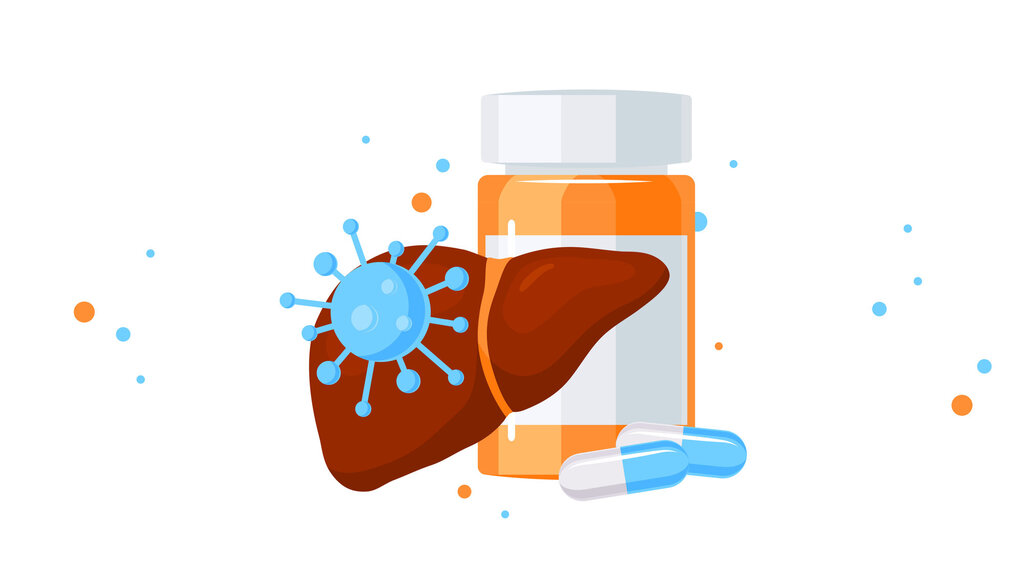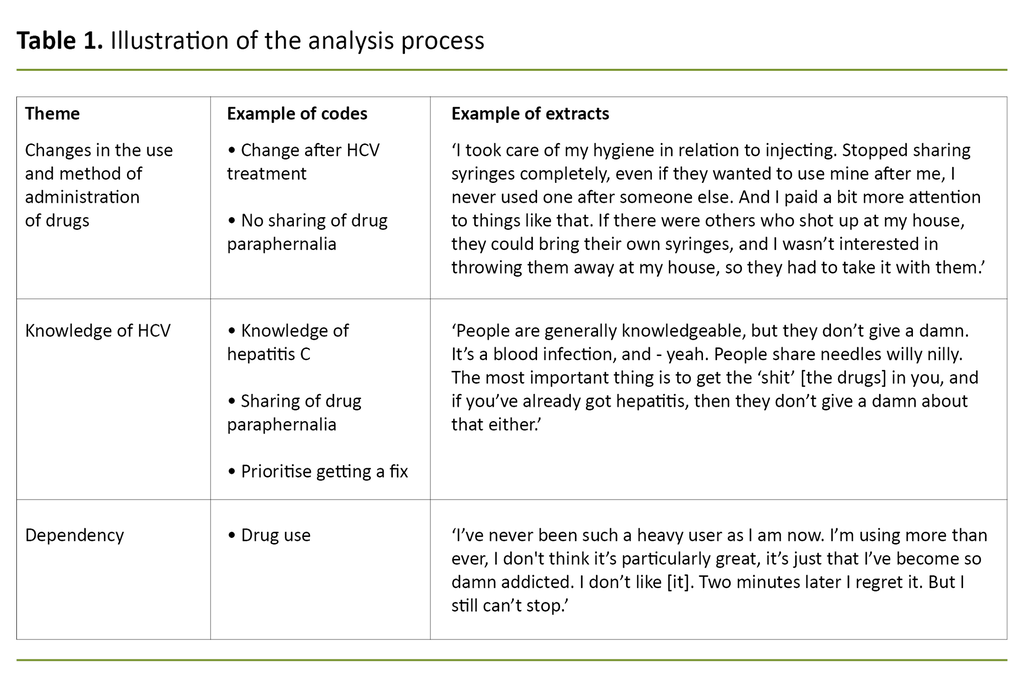Treatment of hepatitis C and changes in substance use – a qualitative study
Background: Hepatitis C is a chronic disease that often has few and non-specific symptoms for several decades before complications arise. In Norway, the aim is to reduce new infections of the hepatitis C virus (HCV) by 90% by 2023. The goal is also for no one to die or become seriously ill from HCV. Intravenous drug users constitute the group that is at highest risk of HCV infection because they share drug paraphernalia such as syringes, needles, ‘cooking’ spoons and cotton wool. With this backdrop, the INTRO-HCV study was conducted in Bergen and Stavanger, where HCV treatment was incorporated into drug-assisted rehabilitation for persons with an opioid addiction.
Objective: The purpose of the study was to explore the significance of HCV treatment for the patients’ substance use.
Method: A qualitative study design with a hermeneutic approach was used. The data are based on 19 semi-structured interviews. The participants were current or former intravenous drug users in drug-assisted rehabilitation or low-threshold services for persons with a drug addiction in Bergen municipality, and were virus-free following HCV treatment. We used Braun and Clarke’s thematic analysis process.
Results: The participants stated that it was more difficult to avoid sharing drug paraphernalia in certain situations, as the drug craving and addiction overshadowed the risk of infection. Their knowledge of how HCV was transmitted also varied. Some confused myths with knowledge. The participants’ substance use changed to varying degrees. Some had made changes before starting HCV treatment, some made changes during treatment, while others did not make any changes. The changes mostly consisted of reducing or stopping the use of substances, changing the method of administration or changing the type of substance.
Conclusion: The study shows that HCV treatment impacted on the substance use of some participants, as being virus-free made it easier to get to grips with their drug addiction. In this context, motivating change and providing information and guidance are an important part of nurses’ health promotion work.
Cite the article
Olsen-Søviknes K, Lorås L, Fadnes L, Carlsen S. Treatment of hepatitis C and changes in substance use – a qualitative study. Sykepleien Forskning. 2023; 18(91190):e-91190. DOI: 10.4220/Sykepleienf.2023.91190en
Introduction
Hepatitis C virus (HCV) is transmitted via blood and causes serious liver disease, which can lead to premature death (1). A chronic phase with few symptoms can last for decades before complications such as liver cirrhosis, liver cancer and liver failure occur (1, 2). There is currently no vaccine against hepatitis C, unlike hepatitis A and B (3).
Since 2016, however, the treatment provision has gradually improved due to the increase in effective medications and competitive bidding, which has pushed purchase prices down. Norway’s goal is that no one should die or become seriously ill from HCV, and that the incidence in the entire population is reduced by 90% by 2023 (4). To achieve this goal, those in the risk group must be tested and treated (4, 5).
In 2010, approximately 10,000 people were living with chronic HCV in Norway (6), but the incidence has been decreasing, especially in recent years (7, 8). Intravenous drug users are a high-risk group for HCV infection (4) due to the culture of sharing drug paraphernalia such as syringes, needles, ‘cooking’ spoons and cotton wool (6). Active substance users are difficult to treat using traditional methods (4, 9).
Preventive measures include free distribution of drug paraphernalia (2) and substitution treatment such as opioid agonist therapy (OAT) for persons with an opioid addiction (10). Because HCV symptoms are often barely discernible, people can live with the disease, often unwittingly, for many years. This can lead to increased infection rates and more extensive liver damage for the person in question (1).
Forty-eight per cent of OAT patients in Bergen have HCV (11). The INTRO-HCV study examines the effect of the incorporation of HCV treatment into OAT centres and low-threshold services in Bergen and Stavanger (12, 13). The study group received HCV treatment from an OAT centre/low-threshold service, while the control group received standard treatment follow-up at a hospital outpatient clinic. All participants were given the same treatment option, an eight- to twelve-week course of tablets (12).
Being addicted to drugs whilst also having HCV-related health problems such as fatigue, muscle pain and depression or anxiety has a negative impact on a person’s health-related quality of life (13). Compared to the general population, persons with a drug addiction (SUD) have a low quality of life (14), and chronic HCV affects their physical, mental and social well-being and functioning (13).
We applied the framework by Dowsett et al. in order to understand what it is like to live with HCV, including how it affects quality of life, physical symptoms, perceived stigmatisation and more (15).
Quality of life is an important topic for registered nurses (RNs), who are concerned with the whole person (15). An important part of RNs’ work is therefore to help improve the quality of life of persons with an SUD.
Objective and research question
In order to gain a better insight into OAT patients’ experiences after HCV treatment, the following research question was formed for the study:
‘How do persons with an SUD describe their substance use after HCV treatment and their virus-free status?’
Method
The study had a descriptive design. We conducted individual interviews (16), and followed the SRQR guidelines for reporting qualitative research.
Sample
The data were obtained through semi-structured interviews, which enabled us to follow up on themes that emerged during the interview (16). The sample consisted of participants of the INTRO-HCV study who had a virus-free blood test after completing HCV treatment (17).
Participants were recruited by research nurses and the first author. The participants represent a strategic sample, where the aim was to include a wide range of backgrounds and ages and a good gender distribution. The project group in the INTRO-HCV study developed the interview guide, where one of the topics was substance use after finishing HCV treatment.
The project group consisted of research nurses, doctors and researchers with in-depth knowledge of addiction. The interview guide was developed based on previous research in the field – empirical evidence – and experiences from the INTRO-HCV study group, which included research nurses, senior researchers and user representatives. We adapted the methodology to the thematic analysis process that was planned.
The interview guide covered topics related to whether they had gained knowledge about HCV that was of significance for their substance use, and whether the treatment had impacted on their drug habit, and if so how.
Data collection
We conducted the interviews at rehabilitation centres, low-threshold services or one of Bergen Hospital Trust’s premises. The ability to conduct an interview undisturbed and easy access for the participants were important factors in the choice of interview location.
The interviews were held in the period June to September 2020 and were recorded on audio tape. Six interviews were conducted by the first author and 13 by research nurses from the INTRO-HCV study. The first author transcribed two interviews, while the rest were sent to a professional transcriber.
Participants
The study participants were a) current or former intravenous drug users, b) receiving OAT or in low-threshold services for persons with an SUD in Bergen municipality, or c) virus-free following HCV treatment in the INTRO-HCV study.
A total of 19 people participated: seven women and twelve men. The participants were aged 35 to 65 years. Six were receiving treatment through a low-threshold service, while 13 were receiving OAT and the associated follow-up.
Analysis
The first author and the last author analysed the data together using Braun and Clarke’s six-phase thematic analysis process (18).
In the first phase, the first author familiarised herself with the content of the data material by reading through all the interviews. In phase two, the initial codes were created, while in phase three, the codes were synthesised and broader themes were created. In the fourth phase, the first and last author reviewed the themes together with the coded data extracts in order to analyse each of the extracts in relation to the context of the theme.
The themes presented in the analysis were defined and delimited in phase five. In the last phase, the analysis was completed, and we selected which quotes were to be used. The analysis process is shown in Table 1.
Ethical considerations
The participants were informed about the purpose of the study. We also explained that participation was voluntary, that sensitive and personal information would be anonymised, and that participants could withdraw at any time without giving a reason. Written informed consent for study participation was obtained for the INTRO-HCV study from the Regional Committee for Medical and Health Research Ethics (REK number 2017/51), which this sub-study is covered by.
Although the participants had the capacity to consent, before each interview we assessed whether the participant was fit to be interviewed, and whether they were high on drugs to an extent that could impair their judgement and capacity to consent.
Results
Through the analysis process, we identified three themes: 1) Dependency, 2) Knowledge of HCV, and 3) Changes in the use and method of administration of drugs.
Dependency
Some participants injected drugs during and after HCV treatment. In some situations, it was difficult to avoid sharing drug paraphernalia. According to one participant, Sundays could be particularly challenging as all follow-up services were closed, and clean equipment was difficult to get hold of.
Some described living with a drug addiction as a perpetual cycle of thinking about the next fix. Although they did not want to inject, several felt that they were ‘controlled’ by their addiction. From an outsider’s perspective, injecting drugs and risking being infected with HCV or other infectious diseases can seem irrational. However, the power of the drug could override everything else, and they would consequently prioritise their need to feed their craving rather than avoid sharing drug paraphernalia. ‘Andreas’ explained it as follows:
‘I’ve never been such a heavy user as I am now. I’m using more than ever, I don't think it’s particularly great, it’s just that I’ve become so damn addicted. I don’t like [it]. Two minutes later I regret it. But I still can’t stop.’
‘Marianne’ described the following:
‘I've even shot methadone two or three times just because I’ve been around so many high neighbours and such like, instead of going down and getting heroin, I’ve just shot some methadone. Because temptation got the better of me.’
The statements illustrate how the addiction, both to the drug itself and to injecting themselves, is so strong that regret and a bad conscience after getting their fix are no obstacle to doing it again. The statement by ‘Marianne’ shows how persons with an SUD can experience their surroundings as ‘triggers’, which can lead to them injecting, and how it is difficult to stay away from drugs and injecting in such settings.
Knowledge of HCV
The participants’ knowledge about how HCV was transmitted varied. Although many knew that HCV was transmitted via blood contact and sharing needles, few knew that sharing ‘cooking’ spoons and cotton wool, or sexual contact, were also possible sources of infection. Several said that sharing ‘cooking’ spoons was common. People who trusted each other, for example close friends or partners, often shared drug paraphernalia.
Some believed that the varying knowledge about HCV among the participants and other persons with an SUD could be related to age. Younger people were less concerned about the consequences and risk of infection with HCV, and they prioritised drugs and sharing drug paraphernalia and were less worried about being infected. ‘Morten’ said the following:
‘People my age, they grew up with different principles. We know how hepatitis is transmitted, but the young ones, they know very little about it [how HCV is transmitted]. They still share needles. [They know nothing about] hepatitis C, HIV or other diseases either.’
Myths can be confused with knowledge, and among persons with an SUD there were several myths about HCV. One myth was that users could be infected if they used their own syringe several times. Another was that completing traditional HCV treatment gave them immunity to HCV. Consequently, they continued to share drug paraphernalia, which in turn may have led to them being reinfected. ‘Inge’ said the following in this regard:
‘If I’d had hepatitis once, you can’t get it twice.’
They also had various theories about how the drug paraphernalia should be cleaned to avoid being infected. ‘Siri’ said the following:
‘Some people think that if you use cold water to wash the plunger, some think you have to use hot water, and some think you have to boil the water and then draw in the boiled water. So it varies [what individuals think].’
These myths show how a lack of knowledge can foster the spread of infection among persons with an SUD. They are also an indication of the importance of providing up-to-date knowledge for this group.
Changes in the use and method of administration of drugs
Some participants had changed their substance use and/or method of administration before receiving HCV treatment, while others made a change during treatment. Nevertheless, some were of the opinion that there was no connection between them becoming drug-free and the HCV treatment. Others made a clear link between the two: being virus-free released them from mental and physical burdens, which meant they had the capacity to get to grips with their drug addiction. In that context, ‘Nils’ said the following:
‘In order to stop taking drugs, you have to feel healthy and that there’s something better [to come]. You don’t do that when you’re sick, you react all the time, sweating at night, not sleeping well, and that affects your appetite.’
Many participants felt in better health after becoming virus-free. They therefore felt it was important not to be reinfected. They talked about different ways of avoiding re-infection, such as planning before taking drugs or postponing it until they had clean drug paraphernalia, or not injecting, or smoking or swallowing them instead. The findings also show that the participants were aware of their own hygiene when injecting and knew how to obtain clean drug paraphernalia. In that connection, ‘Kim’ said the following:
‘I don’t like sharing equipment. If it can be avoided, I’ll avoid it. If I have to keep a shot inside a syringe for two days while waiting for a new needle instead of a used one, I’d rather do that. But I’ve taken drugs in other ways, because if I haven’t got hold of anything else, I've had to sniff or drink them instead.’
This statement illustrates how the participant was more aware of avoiding re-infection with HCV. It requires more planning and avoiding impulsive drug-taking. To prevent reinfection, some participants abstained from drugs. In this context, ‘Stian’ said the following:
‘Since I don’t want to go through that cycle [of HCV treatment] again, I don’t use anything [illegal drugs]. I only use methadone [prescribed OAT medication].’
Discussion
The study shows that the participants found that the HCV treatment impacted on how they thought and acted in relation to the use and method of administration of drugs. In addition, several participants avoided situations that could trigger substance use.
Knowledge and changes
Although many participants knew that HCV was transmitted via blood, especially when injecting, their lack of knowledge about the transmission of HCV through other drug paraphernalia was surprising. It is not easy to avoid sharing drug paraphernalia in some situations, which underlines the importance of preventive measures such as the distribution of drug paraphernalia. However, the participants shared equipment less often after the HCV treatment.
This finding is in contrast to Midgard et al. (19), who found that there was no change in the sharing of drug paraphernalia, either during or after HCV treatment. An Australian study showed that the sharing of needles and syringes did not change after HCV treatment (20), but that the frequency of sharing ‘cooking’ spoons and cotton wool was reduced. Very few of our participants mentioned ‘cooking’ spoons or cotton wool when they talked about drug paraphernalia, which may indicate a lack of knowledge about these as a route of infection.
Sexual contact is a route of infection that the participants spoke little about, which is also consistent with previous research (21). The fact that close friends and partners often shared drug paraphernalia can be interpreted in different ways. One interpretation could be that the sexual intimacy is transferred to the sharing of drug paraphernalia.
Another interpretation could be that friends or sexual partners who live at close quarters and do a lot of sharing in general can also share drug paraphernalia. Syringes are already distributed as a preventive measure, but it should perhaps be questioned whether ‘cooking’ spoons and cotton wool should also be included in this preventive strategy.
We found that some people stopped using drugs intravenously, which is consistent with previous research (19). Being virus-free gave them the physical and mental strength to stay drug-free. It may also have increased their awareness of their health status.
This interpretation is consistent with Batchelder et al. (22), where the participants were more interested in their health and life in general after HCV treatment. Improved health can lead to a better quality of life in the participants, which is supported by Batki et al. (13), who show that people with HCV in OAT have a poorer health-related quality of life than the general population.
We also know that self-stigmatisation, i.e. internalisation of stigma, together with a lot of psychological stress, has a negative impact on the social functioning of persons with an SUD, which impairs their quality of life (23). Therefore, better relationships with family and friends and not being controlled by their substance use can help improve quality of life for many (24).
The desire to reduce or stop the use of substances after HCV treatment can provide scope to act, which RNs should be aware of as they can help motivate persons with an SUD to reduce their substance use or receive treatment for this, thereby improving the person’s quality of life (25).
Generation gap
There may be different explanations for the varying knowledge among persons with an SUD of how HCV is transmitted. The participants highlighted age as a key factor in this context. They cited a generation gap among persons with an SUD – between those who were young in the 1980s and 1990s, who were acutely aware of and feared HIV and AIDS, and the young addicts of today, who are less concerned by this.
Furthermore, participants in their fifties and sixties may have been in a process of change where, after a long life of using drugs, they no longer wanted to be part of the drug scene and were thus more concerned with their health than the younger participants. The oldest participants also seemed to use their knowledge about HCV infection more actively than the younger ones, for example by not sharing drug paraphernalia.
This finding is also supported by Cook et al. (26), who found that participants with fewer than five years of intravenous drug use were more likely to share drug paraphernalia than participants with a longer history of injecting.
Myths need to be debunked
The myth that HCV treatment provides immunity needs to be debunked, as such myths can result in the spread of infection. Information about liver damage in people with HCV is often misunderstood (27). The variation in the level of knowledge about routes of infection in our study may be because the participants did not understand the information given to them, and the myths therefore continue to be perpetuated.
A well-known strategy for debunking myths is to provide factual information to persons with an SUD and people in their immediate environment. Information campaigns can be time-consuming and often have little effect (27), as information in itself does not necessarily lead to behavioural change.
This does not necessarily mean that we should stop providing information, but the information must be easy to understand. Verbal and written information should be provided regularly, as some persons with an SUD lead chaotic lives and have various cognitive challenges (28). RNs who work closely with persons with an SUD and provide health-promoting information are therefore crucial to this work.
Strengths and limitations of the study
One of the strengths of the study is the number of interviews, the broad span of ages and the fact that both sexes are well represented. The methodological approach enabled us to obtain different perspectives on how HCV treatment may have led to changes in substance use.
A possible limitation of the study is the length of the interviews. On average, the interviews lasted 40 minutes. If they had been longer, we may have been able to gain a more in-depth understanding and explore each question in more detail. However, Fadnes et al. (29) show that memory impairment and selective memory affect participants’ responses. A longer interview would, therefore, have been challenging for some participants and difficult to carry out due to their concentration problems, lack of memory and restlessness.
Researchers’ preconceptions can be a strength and a weakness. The analysis was carried out by researchers with extensive knowledge about drug users. This prior knowledge can influence the interpretation of the data, for example with expressions and slang words used in the interviews being interpreted and used in the analysis.
We consider such preconceptions a strength. However, they can also be a weakness, as certain terms can be assumed, without the researcher exploring exactly what the individual means. In such cases, misunderstandings can arise in how the various terms are used.
Objectivity is often sought in research. In qualitative studies, we are aware that the lens of research can influence the study, and that the researchers’ understanding does not always align with that of the participants. We remained aware throughout the entire analysis process in this study of how our contribution could influence the research. By using a data-driven inductive analysis process, several research nurses to interview the participants, and contributions to the analysis process from other members of the project group, we have tried to dilute the possibility of the researchers’ preconceptions dominating.
Conclusion
The desire of persons with an SUD to ease withdrawal symptoms coupled with the craving for a fix can lead to the sharing of drug paraphernalia, especially if clean equipment is not readily available. Although some people change their substance use prior to HCV treatment, there are more who make changes during and after treatment. These changes may be due to a desire to take care of their health and thus change their lifestyle, including less harmful substance use. A few also stopped using drugs altogether.
HCV treatment gives us RNs an opportunity to motivate persons with an SUD to change their substance use. It is particularly important for RNs to have knowledge of this scope to act in order to carry out good preventive and health-related work.
The authors declare no conflicts of interest.
The Study's Contribution of New Knowledge

Most read
Doctorates
Selvrealisering og betydning for helsesykepleieres fortsatte yrkesutøvelse. En kvalitativ studie.
Dårlig samvittighet hos sykepleiere - En multimetodestudie om sykepleieres erfaring med dårlig samvittighet i sykehjem og hjemmebasert omsorg
Helserelatert livskvalitet og mental helse etter ekstremt prematur fødsel
Å leke med dukker i sykepleierutdanningen

















Comments